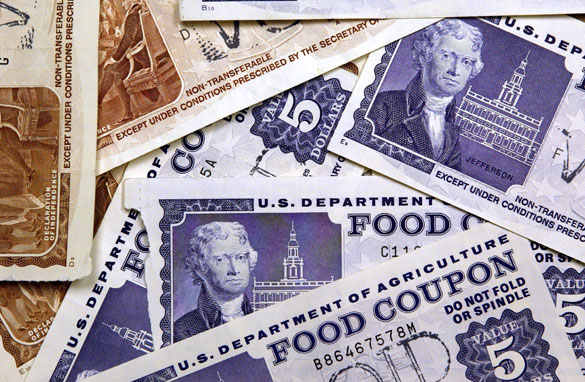 Dear friends,
Do not fear, for I have taken your historical topics to heart and said posts shall be appearing in the near future. However, due to the fact that I was approved to received food stamps today, I thought I'd celebrate that bounteous joy bestowed upon us by the federal government in this week's post.
Today the program is known as the Supplemental Nutrition Assistance Program or SNAP. Like the dragon. Or what beatniks do at poetry readings. It is a form of federal assistance administered through the Department of Agriculture. And my impoverished graduate student state qualifies me to received its benefits. According to this detailed article at Wiki-source of all universal knowledge-pedia, ten percent of the U.S. population receives SNAP benefits. I am proud to join their ranks.
Annnnnyway, the first food stamp program was implemented in 1939, partly under the leadership of VP of communists and poultry Henry Wallace, of agricultural fame. The program was designed to put food surpluses into the hands of needy people. Which were a lot of people in the '30s. You know. Like now! Stamps were recieved through a purchasing program. Participants had to buy certain amounts of food to get vouchers for other food that were in surplus.
Dear friends,
Do not fear, for I have taken your historical topics to heart and said posts shall be appearing in the near future. However, due to the fact that I was approved to received food stamps today, I thought I'd celebrate that bounteous joy bestowed upon us by the federal government in this week's post.
Today the program is known as the Supplemental Nutrition Assistance Program or SNAP. Like the dragon. Or what beatniks do at poetry readings. It is a form of federal assistance administered through the Department of Agriculture. And my impoverished graduate student state qualifies me to received its benefits. According to this detailed article at Wiki-source of all universal knowledge-pedia, ten percent of the U.S. population receives SNAP benefits. I am proud to join their ranks.
Annnnnyway, the first food stamp program was implemented in 1939, partly under the leadership of VP of communists and poultry Henry Wallace, of agricultural fame. The program was designed to put food surpluses into the hands of needy people. Which were a lot of people in the '30s. You know. Like now! Stamps were recieved through a purchasing program. Participants had to buy certain amounts of food to get vouchers for other food that were in surplus.The program fizzled out by 1943 when the economy was doing better and there was that whole "World War II" thing going on. Whatevskis. So we didn't have food stamps for a long time. People in Congress tried to work on it, passing a bill in 1959. Eisenhower didn't do anything with it though. Kennedy made a campaign promise to launch a pilot program, and with his first Executive Order did so. From 1961-64, America tried out having a food stamp program again. Then! In 1964! There was a Food Stamp Act! LBJ wanted the program to be made permanent, so Congress put it into law, leaving the states in charge of eligibility. In 1971, we expanded benefits to our Imperial Islands of Guam, Puerto Rico, and the Virgin Islands. The program officially went nationwide in 1974. In more exciting developments, the purchase requirement was eliminated in the late '70s, huzzah! At which point (January 1979) the program increased in size by 1.5 million recipients in one month. Totes. Why would we try to help poor people buy more/healthier food if you're going to require them to spend money first to do it? Doesn't that kind of defeat the purpose? Do some people in Congress not really understand what the phrase "low-income" means? For cereal, people.
Anyway, in a shocking turn of events, St. Ronald of Reagan and his crew made some serious cutbacks to the program in the early '80s. Because god forbid we make any progress in improving our social safety net. Social... Socialism.... SOCIALIST!!!! AMERICA IS SOCIALIST AND I LOVE IT BECAUSE IT GIVES ME FREE FOOD! Ahem. But shitty economic conditions required us to re-expand the program in the mid to late '80s. And no we have no sales tax on food stamp purchases. Also, the first EBT (electronic benefits transfer) programs emerged at this time. Which is good, because I am a PRO at swiping cards at the store, and not at keeping track of tiny paper stamps. But then... I don't know if you guys remember the mid-'90s much. There was great music, I began to experience puberty, and douchey douche Newt Gingrich signed a Contract with America. Some bullshit about "personal responsibility" and "work opportunity" screwed over people on welfare for awhile. The Farm Bill of 2002 restored rights to (legal) immigrants to collect benefits, and us ABAWDs (able-bodied adults without dependents) got helped out too. Anyways, the fact of the matter is that especially in urban areas, housing costs in the U.S. far outweigh the percentage of income devoted to food purchases. So the benefits are largely used for income maintenance. I'm definitely on that train. Anyway, we don't do a great job with helping people in America, but some days, some of us are poor enough, and we benefit.

No comments:
Post a Comment